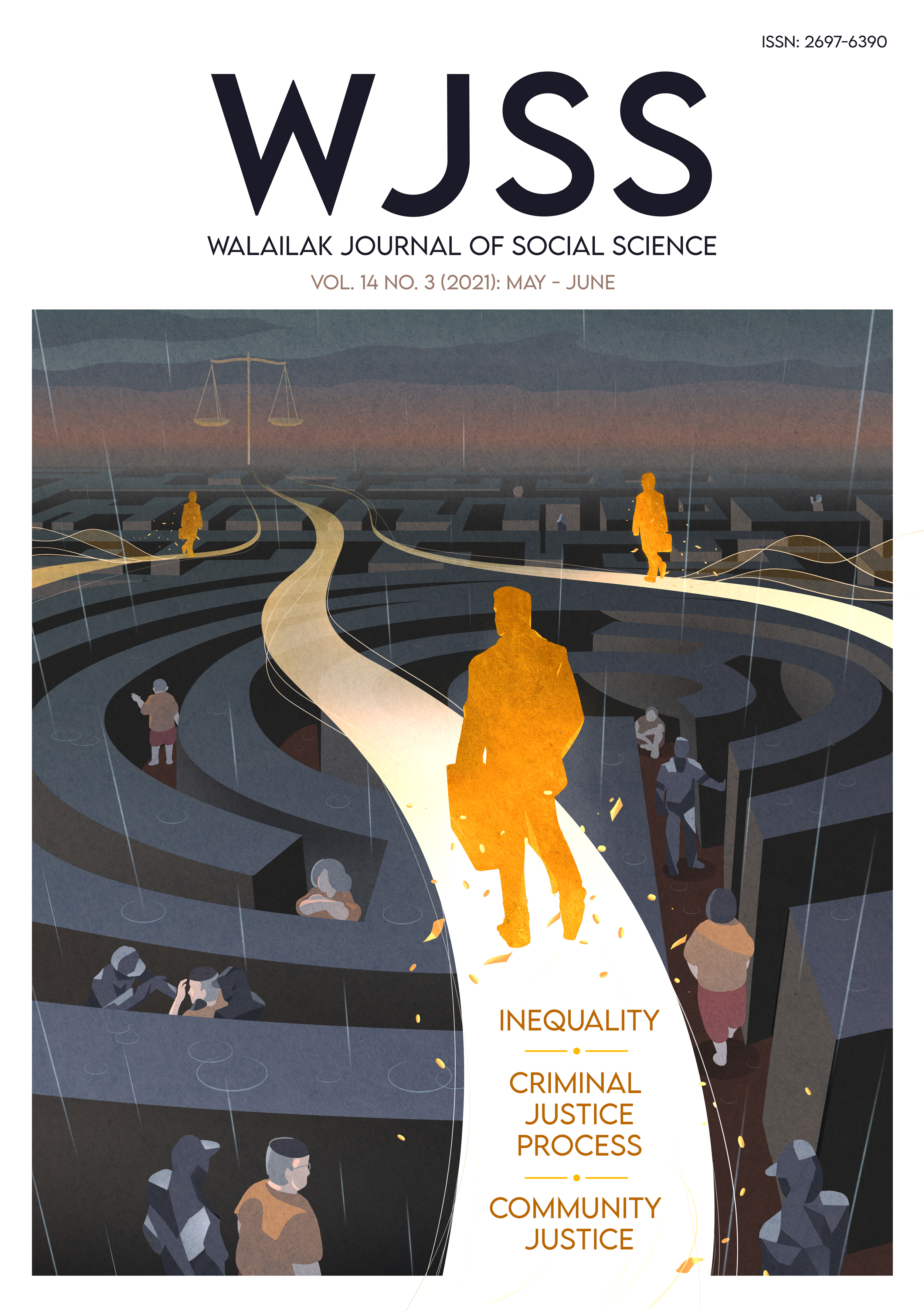Guidelines for Enhancing Institutional Commitment of Students at Risk of Dropping Out of Walailak University
Main Article Content
Abstract
This research aims to 1) identify the level of engagement factors for students at risk of dropping out of Walailak University, 2) compare the factors in the institutional engagement of students at risk of dropping out of Walailak University classified by gender, department of study, and year, and 3) find ways to strengthen engagement with students at risk of dropping out of Walailak University. This research was conducted using an explanatory sequential mixed method design. The procedure was divided into 2 phases and carried out with a sample group of 202 students at risk of dropping out of Walailak University during the academic years 2016-2019. For Phase 1’s quantitative part, descriptive statistics were employed for data analysis which included percentage, arithmetic average, standard deviation, and t-test and f-test. In case of statistically significant differences, multiple comparisons were made by the least significant difference (LSD). For Phase 2’s qualitative part, the instrument used was a focus group discussion for seeking ways to strengthen commitment to the institution. The data was analyzed using content analysis.
The results of the research can be summarized as follows: 1) Students at risk of dropping out of Walailak University expressed a high level of overall institutional commitment, 2) Students at risk of dropping out of Walailak University, categorized by gender and department, demonstrated no relationship with the institution as a whole. However, students of different years of study showed statistically significant ties to the institution at level .05, and 3) The approaches which demonstrated a strengthening of the engagement of students at risk of terminating their studies at Walailak University were in six areas, namely: 1) relationships with peers, seniors and juniors, 2) rapport with teachers, such as training skills where teachers play a role in mentoring students, 3) atmosphere in the educational institution, such as improving environments, educational materials and technology, 4) a sense of institutional ownership, 5) institutional engagement, and 6) belief in the institution, such as encouraging students to have a more balanced quality of academic life, and well-being.
Article Details
Copyright: CC BY-NC-ND 4.0
References
Astin, A. W. (1990). What matters in college? San Francisco: Jossey-Bass.
Crittenden, J., & Peter, L. (2018). Civic education, the Stanford encyclopedia of philosophy. Retrieved from https://plato.stanford.edu/archives/fall2018/entries/civic-education
Eggert, L. L. (1994). Preventing adolescent drug abuse and high school dropout through an Intensive school - based social network development program. American Journal of Health Promotion, 8, 202-215.
Faure, E., Herrera, F., Kaddoura, A. R., Lopes, H., Petrovski, A. V., Rahnema, M., & Ward, F. C. (1982). Learning to be: The world of education today and tomorrow. (7th eds.). Offset Aubin: United Nation.
Galliher, R. V., Evans, C. M., & Weiser, D. (2007). Social and individual predictors of Substance use for Native American youth. Journal of Child and Adolescent Substance Abuse, 45(3), 233-240.
Khamkerd, T. (1998). A learning organization. Academic Journal, 1(9), 29-33.
Khamphon, P., & Apibunyopas, J. (2018). A study of the causal model of issuing drop off of Walailak University students. Journal of Education Chulalongkorn University, 47(1), 240-262.
Marginson, S. (2016). The worldwide trend to high participation higher education: Dynamics of social stratification in inclusive systems. Higher Education, 72, 413-434.
Meesaen, N. (2015). Relationships to the student organization Dhurakij Pundit University (Doctoral dissertation). Bangkok, Thailand: Srinakharinwirot University.
Mowday, R. T., Porter, L. W., & Steers, R. W. (1982). Employee-Organizational linkage: The psychology of commitment absenteeism and turnover. New York: Academic Press.
Newcomb, M. (1962). Student peer-group influence in personality factors on the college campus. New York: Social Science Research Council.
Pimpa, C. (2004). Environmental management in basic educational institutions under the Sakon Nakhon Educational Service Area Office. Master of Education Thesis, Field of Study Graduate school Sukhothai Thammathirat Open University, Bangkok.
Sinlarat, P. (2012). Creative and Productivity Leader: New Paradigm and New Leader in Education (Master’s thesis). Bangkok, Thailand: Chulalongkorn University.
Sinnoi, M. (2007). Factors affecting drop out of undergraduate students of Ubon Ratchathani University (Master’s thesis). Ubon Ratchathani, Thailand: Ubon Ratchathani University.
Steers, M., & Porter, L. M. (1983). Employee commitment to organization in motivation & work behavior. (3rd eds.). New York: McGraw-Hill.
Tinto, V. (1997). Classrooms as communities: Exploring the educational character of student persistence. Journal of Higher Education, 68(6), 599-623.
Walailak University. (2019). Retrieved from http://th.wikipedia.org/wiki/WalailakUniversity
Wanichsupawong, P. (2003). Educational research methodology. Pattani, Thailand: Faculty of Education, Prince of Songkla University.
Wattananarong, A. (2006). Research report on funding of public higher education institutions in Thailand. Bangkok, Thailand: Faculty of Education, Srinakharinwirot University.
Wattananarong, K. (2012). Innovation and technological education. (2nd eds.). Bangkok, Thailand: King Mongkut’s University of Technology North Bangkok.
Wickert, C. (2019). Social bonds theory (Hirschi). Retrieved from https://soztheo.de/theories-of-crime/control/social-bonds-theory-hirschi/?lang=en
Wongsuraset, S. (2009). Organizational commitment of Kasikornbank public company limited (Master’s thesis). Chiang Mai, Thailand: Chiang Mai University.


